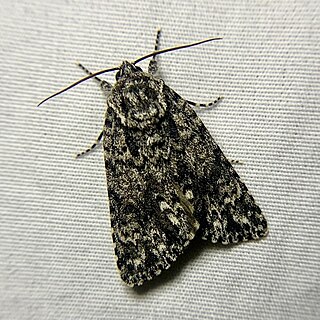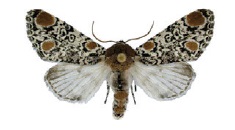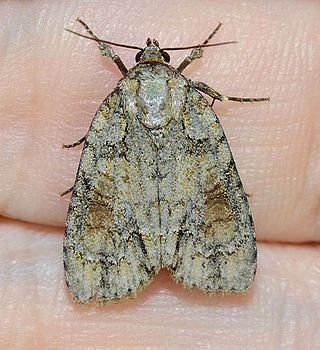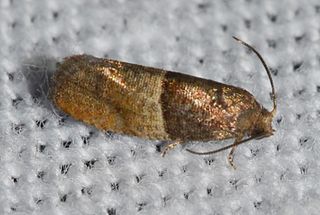
Maryland is a state in the Mid-Atlantic region of the United States. The state borders Virginia to its south, West Virginia to its west, Pennsylvania to its north, Delaware to its east, the Atlantic Ocean, and the national capital of Washington, D.C. With a total land area of 12,407 square miles (32,130 km2), Maryland is the ninth-smallest state by land area, and its population of 6,177,224 ranks it the 18th-most populous state and the fifth-most densely populated. Maryland's most populous city is Baltimore, and the capital is Annapolis. Occasional nicknames include Old Line State, the Free State, and the Chesapeake Bay State. It is named after Henrietta Maria, the French-born queen of England, Scotland, and Ireland during the 17th century.

The Arctiinae are a large and diverse subfamily of moths with around 11,000 species found all over the world, including 6,000 neotropical species. This subfamily includes the groups commonly known as tiger moths, which usually have bright colours, footmen, which are usually much drabber, lichen moths, and wasp moths. Many species have "hairy" caterpillars that are popularly known as woolly bears or woolly worms. The scientific name Arctiinae refers to this hairiness. Some species within the Arctiinae have the word "tussock"' in their common names because they have been misidentified as members of the Lymantriinae subfamily based on the characteristics of the larvae.

Schinia, commonly called flower moths, is a large genus of moths belonging to the family Noctuidae. The genus has a Holarctic distribution with the vast majority of species being found in North America, many with a very restricted range and larval food plant.

Acronicta lithospila, the streaked dagger moth, is a moth of the family Noctuidae described by Augustus Radcliffe Grote in 1874. It is found in Canada and the United States.

Acronicta noctivaga, the night-wandering dagger moth, is a species of moth in the family Noctuidae. It is found in north-eastern North America including Wisconsin, New York, Maryland and Ontario.

Schinia nundina, the goldenrod flower moth, is a moth of the family Noctuidae. The species was first described by Dru Drury in 1773. It is found in North America from Minnesota to southern Ontario and Nova Scotia, south to central Florida and southern Texas. Records include Arizona, Kansas, Nebraska, New York, Maryland, Oklahoma and South Carolina.

Photedes enervata, the many-lined cordgrass moth, previously known as Hypocoena enervata, is a species of moth of the family Noctuidae. It is found in marshes along the Atlantic Coast of North America, with scattered inland wetlands records from Nova Scotia and New Brunswick south to Florida.
Hypocoena inquinata, the sordid wainscot or tufted sedge moth, is a moth of the family Noctuidae. The species was first described by Achille Guenée in 1852. It is found across Canada from Newfoundland to British Columbia, south in the east to Connecticut and Ohio and in the west to Colorado.
Acronicta tristis is a moth of the family Noctuidae. It is found from Ontario, Quebec and New Brunswick, south to Maryland, Pennsylvania and Ohio.

Harrisimemna trisignata, or Harris's three spot, is a moth of the family Noctuidae. The species was first described by Francis Walker in 1856. It is found in North America from Ontario, Quebec, New Brunswick, Nova Scotia, Newfoundland and Labrador, Alberta and Saskatchewan, south to Arizona. In the United States it has been recorded in Maryland, Pennsylvania, Wisconsin, Georgia, Illinois, Indiana, Iowa, New York, Ohio, Oklahoma, Tennessee, Texas and Virginia.

Apamea cariosa is a moth of the family Noctuidae. It is found in the northeastern United States, including New York, Maryland, Indiana and Virginia. In Canada it is found in Ontario, Quebec, New Brunswick, Alberta, and Manitoba.

Apamea vulgaris is a moth of the family Noctuidae. It is found from Nova Scotia to Kentucky, and west to Kansas. It has been recorded from Ontario, New York, Pennsylvania and Maryland.

Acronicta exilis, the exiled dagger moth, is a moth of the family Noctuidae. The species is found in North America, including Iowa, New York, Maryland Arkansas and Delaware.

Gabara subnivosella, the wet sand savannah moth, is a moth in the family Erebidae. The species was first described by Francis Walker in 1866. It is found in North America from Manitoba south to Maryland, Massachusetts and New York.

The spinose flower moth is a moth of the family Noctuidae. It is found in North America, including New York and Maryland.

Schinia nubila, the camphorweed flower moth or brown flower moth, is a moth of the family Noctuidae. The species was first described by Herman Strecker in 1876. It is found from the US states of Oklahoma to New Jersey, south to Florida and Texas. Its range is expanding in the northeast. Furthermore, recorded from Colorado, Kansas, Oklahoma, Arkansas, North Carolina, South Carolina and Maryland.

Psaphida grandis, the gray sallow, is a moth of the family Noctuidae. The species was first described by John Bernhardt Smith in 1898. It is found in North America from Ontario, south to Florida. It has been recorded from Iowa, New York, Maryland, South Carolina, Arkansas, Michigan and Wisconsin.

Larisa is a genus of moths belonging to the subfamily Olethreutinae of the family Tortricidae. It contains only one species, Larisa subsolana, which is found in North America, where it has been recorded from Alabama, Florida, Georgia, Illinois, Indiana, Kentucky, Maine, Maryland, Massachusetts, Minnesota, Mississippi, Missouri, New York, Ohio, Oklahoma, Ontario, Quebec, South Carolina, Tennessee, Texas, Virginia, and West Virginia.

The many-spotted dichomeris moth is a moth of the family Gelechiidae. It is found in the United States, including Alabama, Maine, Maryland, Massachusetts, New Hampshire, Tennessee, Texas and Virginia.
Spilosoma latipennis, the pink-legged tiger moth, or the red-legged diacrisia, is a moth in the family Erebidae. It was described by Richard Harper Stretch in 1872. It is found in eastern North America, where it has been recorded from Georgia, Indiana, Iowa, Kansas, Kentucky, Maine, Maryland, New Brunswick, New York, North Carolina, Ohio, Ontario, Pennsylvania, South Carolina, West Virginia and Wisconsin.













